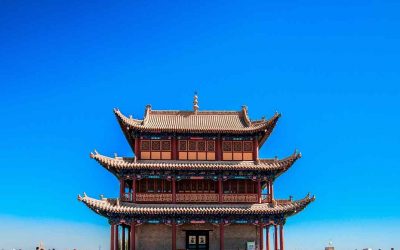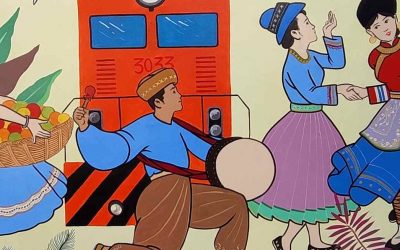Buddhist Immersion from Shanghai: No Need to Board a Plane—Paradise Is Right at Your Doorstep
Residents of Shanghai eager to learn more about Buddhist art and history often think they must undertake long journeys to reach the sacred mountains of this religion. What many don’t realize is that Buddhist mountains with ancient temples, tranquil settings, and a deep spiritual atmosphere are located just a few hours from the city. For the curious traveler, a completely different world awaits nearby: ancient temples veiled in mist, barefoot pilgrims, hills steeped in history, and mountains that have served as sanctuaries for over a thousand years.
A basic itinerary could take the traveler to four key sites in Zhejiang Province: the Temple of the Hidden Soul in Hangzhou, Putuo Island, and the mountains of Tiantai and Xuedou.
Hangzhou and the Temple of the Hidden Soul
Before it became famous for its lake or Longjing tea, Hangzhou was a sacred city in the Buddhist world. During its golden age, it reportedly housed over 300 Buddhist temples, and even today, it preserves several of great beauty. The most renowned is the Temple of the Hidden Soul (Lingyin Si), founded in the 4th century by the Indian monk Hui Li. Its name means «Temple of Spiritual Retreat,» and since its founding, it has been one of the most revered centers of Chan (Zen) Buddhism in southern China.
Lingyin has been rebuilt many times, but still retains its solemn and powerful atmosphere. Over the centuries, it was patronized by emperors, reformed by renowned monks, and served as a stage for spiritual retreats, doctrinal debates, and pilgrimages. Today it remains home to an active monastic community and thousands of visitors who find a sense of quiet contemplation in its halls and courtyards—a stark contrast to the bustle of modern Hangzhou. The three main halls are especially majestic, and the statue of Weituo in the Hall of the Heavenly Kings was carved nearly 1,000 years ago.
Opposite the temple lies Feilaifeng (the «Flying Peak»), which legend says was brought from India by Hui Li himself. In reality, it houses more than 300 rock-carved Buddhist sculptures dating from the 10th to the 14th century, many in Song Dynasty style, and others with Tibetan influence—making it the only site in eastern China with such sculptural richness. The figures depict Buddhas, bodhisattvas, celestial guardians, and scenes from the sutras. It is one of the largest Buddhist stone-carving complexes in southern China and an open-air museum still little known to foreign visitors.
Putuoshan: The Island of Compassion
Off the coast of Zhoushan lies Putuo Island (Putuoshan), one of the four great sacred mountains of Chinese Buddhism. It is revered as the earthly abode of Guanyin, the bodhisattva of compassion. The cult of Guanyin on the island dates back to the 9th century, but it gained national prominence in the 10th century, attracting monks, emperors, merchants, and countless devotees.
During the Ming and Qing dynasties, Putuoshan became one of East Asia’s major pilgrimage centers. Over a hundred temples and hermitages once covered the island, along with stone steles, votive bridges, and shelters for pilgrims.
Today, the main temples are Puji Si (the ritual and administrative heart of the island), Fayu Si (noted for its elegant wooden pavilions), and Huiji Si, located atop the island’s highest point. Beyond its religious significance, Putuoshan offers an atmosphere of unparalleled serenity: secluded beaches, bamboo-lined paths, monks walking with umbrellas, and temple bells ringing at dusk.
Tiantai Shan: Cradle of a Philosophical School
Less known to the general public but of tremendous doctrinal significance, Mount Tiantai was where the monk Zhiyi founded one of China’s earliest native Buddhist schools in the 6th century: the Tiantai School, based on a systematic interpretation of the Lotus Sutra (Fahua Jing).
Unlike other traditions that emphasized meditation or devotional faith, Tiantai developed a sophisticated philosophical system combining contemplation, doctrinal analysis, and ethical practice—a “middle path” between the emptiness of Indian Mahayana and the reality of everyday life. Its influence was so profound that, in the 9th century, the Japanese monk Saichō traveled to Tiantai, studied there, and later founded the Tendai School in Japan, which became one of the pillars of medieval Japanese Buddhism.
The spiritual center of this tradition is the Guoqing Temple, founded by Zhiyi around the year 598. Though rebuilt in various periods, it retains its original layout and several ancient architectural elements. It is surrounded by stone paths, misty forests, and arched bridges. The temple preserves Ming Dynasty statues, inscriptions with Zhiyi’s verses, and a commemorative stele from Emperor Wendi of the Sui Dynasty. The atmosphere at Tiantai is deeply introspective—ideal for those seeking to understand Buddhism not just as faith, but as a living philosophy.
Xuedou Shan: The Smiling Buddha and the Hidden Mountain
West of Ningbo, in the valleys of Xikou, lies Mount Xuedou, traditionally associated with Budai, the “fat, happy Buddha” often seen as a local incarnation of Maitreya, the Buddha of the future. This figure—always depicted with a big belly and wide smile—embodies a joyful, approachable spirituality.
The current Xuedou Temple has been rebuilt and expanded in recent years. Its highlight is a colossal golden statue of Budai, visible from miles away and now a symbol of the mountain. But more than its size, what draws visitors is the contrast between Budai’s benevolent humor and the solemnity of more austere temples. Xuedou represents the human, smiling side of Chinese Buddhism—the side that comforts, laughs, and embraces.
Suggested Itinerary
Given their proximity to Shanghai (and of course, to Hangzhou and Ningbo), these temples can be visited on a multi-day excursion from the financial metropolis—or in a series of shorter weekend trips. A suggested itinerary could be:
- Shanghai → Hangzhou
High-speed train from 46 minutes. If heading to central Hangzhou station—more convenient for visiting Lingyin Temple—allow about 90 minutes in total. - Hangzhou → Ningbo
High-speed rail (~1 hour). From Ningbo, travel by road to Zhoushan or to the port for the ferry to Putuoshan (about 90 minutes). - Putuo → Xuedou Shan
From Zhoushan to Xuedou takes around 2 hours by car. Continue from Xuedou to Tiantai Shan (approx. 2 hours by road). - Tiantai → Shanghai
Direct train to Shanghai (approx. 2 hours).
About me: I have spent 30 years in China, much of the time traveling and studying this country’s culture. My most popular research focuses on Chinese characters (Chinese Characters: An Easy Learning Method Based on Their Etymology and Evolution), Matriarchy in China (there is a book with this title), and minority cultures (The Naxi of Southwest China). In my travels, I have specialized in Yunnan, Tibet, the Silk Road, and other lesser-known places. Feel free to write to me if you’re planning a trip to China. The agency I collaborate with offers excellent service at an unbeatable price. You’ll find my email below.
Last posts
Midnight by Mao Dun – a failed novel
Midnight by Mao Dun - a failed novel Before reading "Midnight", the masterpiece of Mao Dun, the most powerful Chinese writer in the twentieth century, reading the presentations of the Chinese edition, one wonders why such a great literary treasure is not better known...
Cold Steel – A Sniper’s War
Cold Steel - A Sniper's War If in the West war films are a genre in their own right, in China they are an even more important genre, and that is because there is always an interest on the part of the official media to remember the two great war events that gave rise...
A Woman, a Gun and a Noodle Shop
A Woman, a Gun and a Noodle Shop Directed by Zhang Yimou: 2009. 85. Min. A Woman and a Gun and a Chinese Noodle House is a quite singular work within Zhang Yimou's filmography. His light-hearted style starts from the first scenes, in which we see the protagonist with...
Jiayuguan Pass – the Great Wall on the Silk Road
Jiayuguan Pass - the Great Wall on the Silk Road Jiayuguan Pass or Jiayu Pass, as guan means pass in Chinese is one of the most remarkable monuments on the Silk Road and one of its most popular sights. Built at the end of the Great Wall, showing the desolation of the...
Springtime in a Small Town: The best film in China’s history
Springtime in a Small Town: The best film in China's history All the rankings made in recent years, place a film, unknown to the general public, as the best film in China. It is called "Springtime in a Small Town" and was directed by Fei Mu in 1948. I had been wanting...
The Character and Function of Music in Chinese Culture
The Character and Function of Music in Chinese Culture In 1946 Bliss Wiant finished his Doctoral dissertation . The subject was “The character and function of Music in Chinese culture.” Some of his reflections are so interesting that I share with readers here some...










